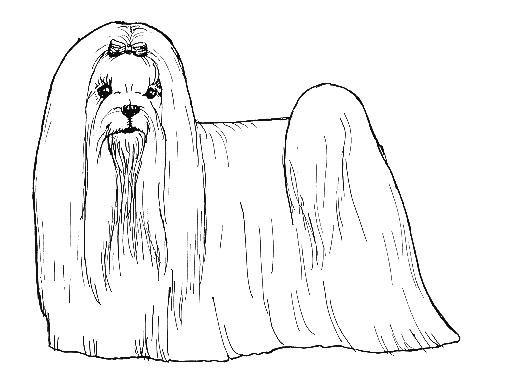Maltese
Companion Dog Group
The goals and purposes of this breed standard include: to furnish guidelines for breeders who wish to maintain the quality of their breed and to improve it; to advance this breed to a state of similarity throughout the world; and to act as a guide for judges.
Breeders and judges have the responsibility to avoid any conditions or exaggerations that are detrimental to the health, welfare, essence and soundness of this breed, and must take the responsibility to see that these are not perpetuated.
Any departure from the following should be considered a fault, and the seriousness with which the fault should be regarded should be in exact proportion to its degree and its effect upon the health and welfare of the dog and on the dog’s ability to perform its traditional work.
History
The Maltese, one of the many Bichon breeds indigenous to the areas surrounding the Mediterranean Sea, is believed to be as much as 2,000 years old. It is of spaniel origin, descending from the same stock that produced the Portuguese Water Dog, the Barbet and the Poodle. The breed was prized for its beauty and companionship, especially by women.
The Maltese was recognized by the United Kennel Club in 1948.
General Appearance
The Maltese is a toy type, “bichon†breed, covered from head to feet with long, silky, white hair falling in a mantle.
It is rectangular in proportion and has a proud, elegant carriage.
Characteristics
Intelligent, lively and very affectionate, the Maltese is a docile companion.
Head
The length of the head is equal to slightly more than half the height at the withers. It is fairly broad, in width measuring a little more than one-half the length.
SKULL
The skull is slightly longer than the muzzle, and is as broad as it is long. Flat on top, it is rounded at the sides and somewhat oval in shape when viewed from above. It joins the muzzle at a well-defined stop.
MUZZLE
The muzzle is well-chiseled and is longer than it is deep. The upper and lower lips meet in such a way that the bottom profile of the muzzle is defined by the lower jaw, not the flews. The edges of the lips must be black.
TEETH
A full complement of strong, white teeth meet in a scissors bite.
Faults: Overshot or undershot bites.
EYES
The dark brown, round eyes are set not too far apart. Eye rims are close-fitting, and black; and enhance the gentle, yet alert expression.
Serious Faults: Wall eyes, lack of eye rim pigmentation.
NOSE
The small, round nose is black.
Serious Faults: Dudley nose or nose any color other than black.
EARS
Triangular in shape and set above the zygomatic arch, the drop ears hang close to the side of the skull and have little erectile power.
Neck
Fairly long and arched at the crest, the neck is carried erect and is free from loose skin.
Forequarters
The shoulder blades slope at a moderate angle.
FORELEGS
The legs are straight and parallel to one another. They are lean but have sturdy bone for a dog of this size. Pasterns are short and upright.
Body
The body is compact and balanced. The height, measured from the withers to the ground, is equal to the length, measured from the withers to the base of the tail. The topline is level. The strong, taut loins are just slightly tucked up underneath. The chest is deep, reaching below the level of the elbow. The ribs are moderately sprung.
Faults: Roached back. topline not level. Excessive body length that spoils the compact appearance.
Hindquarters
Nicely muscled, with sturdy bone structure.
HIND LEGS
Straight and parallel to one another from hip to foot when viewed from behind. Moderately angulated at stifle and hock. Rear pasterns short and vertical.
Feet
The small, round feet have black toe pads. The hair on the feet may be trimmed to give a neater appearance.
Tail
The longhaired tail is set high and is carried gracefully and well arched over the back. The tip touches the croup or lies to either side over the quarters.
Serious Faults: Lack of tail or a shortened tail, whether natural or docked.
Coat
The breed is single coated (having no undercoat). The silky, straight, flat coat hangs long over the sides of the body from a center part almost, if not quite, to the ground. It should not impede movement. The long hair on the head may be tied up in a single or double topknot or left hanging.
Faults: Any suggestions of kinkiness, curliness, woolly texture or cosmetic alteration. Undercoat.
Color
Pure white. An ivory tinge, or traces of orange, are permitted but they are considered an imperfection.
Height & Weight
Height at the withers for males is 8¼ to 10 inches. For females it is 7 ½ to 9 inches.
Weight is six to eight pounds.
Gait
Smooth and even, giving the impression that the feet just skim the ground. At a trot, the steps are short, free and very quick.
Disqualifications
(A dog with a Disqualification must not be considered for placement in a conformation event, and must be reported to UKC.)
Unilateral or bilateral cryptorchid.
Viciousness or extreme shyness.
Albinism.

Looking for a Dog?
Find a dog that will fit your family.
Note: The breeders on this list are not endorsed by UKC.
Revised May 1, 2017
©Copyright 1992, United Kennel Club
